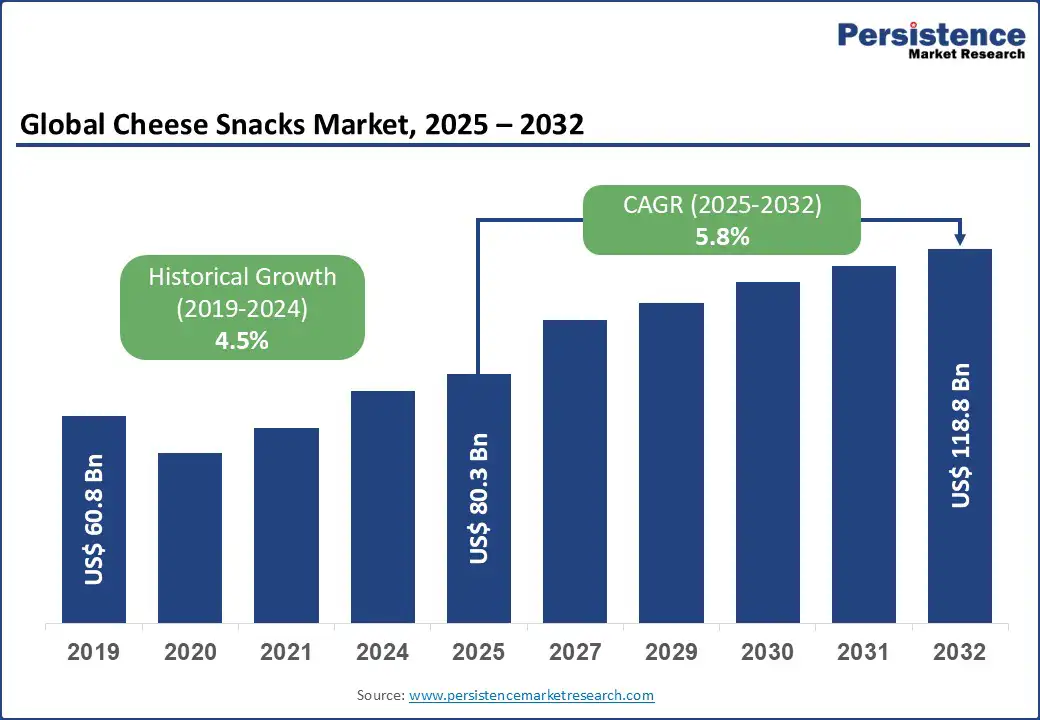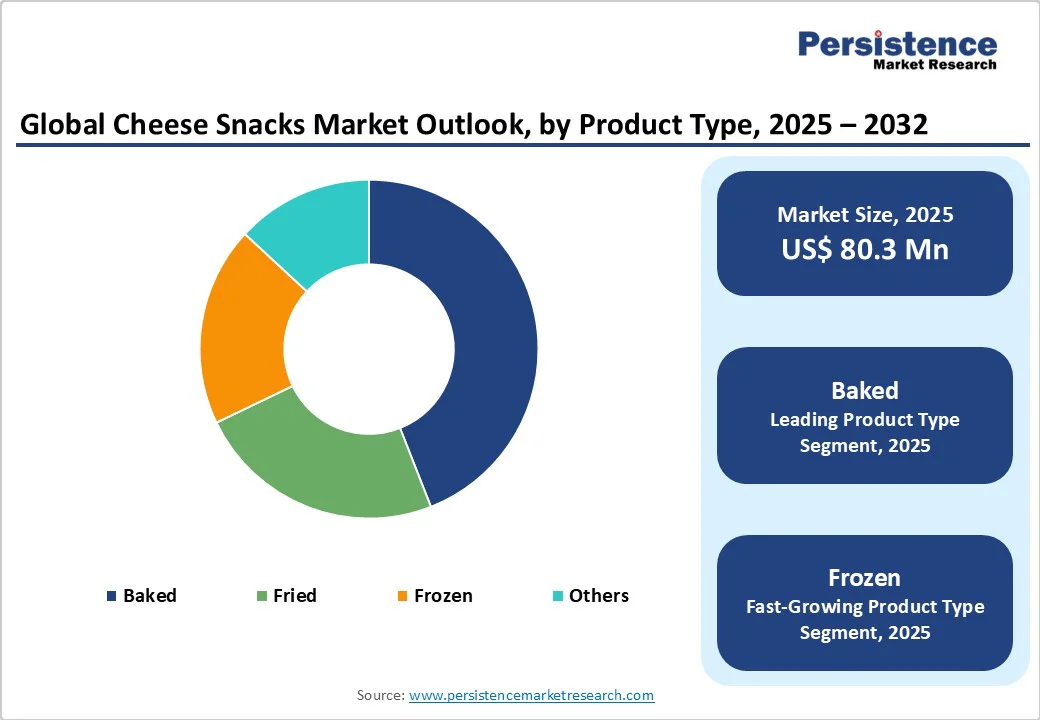ID: PMRREP22366| 178 Pages | 15 Oct 2025 | Format: PDF, Excel, PPT* | Food and Beverages

The global cheese snacks market size is expected to reach US$80.3 billion by 2025. It is estimated to reach US$118.8 billion by 2032, growing at a CAGR of 5.8% during the forecast period 2025 - 2032, driven by the rising demand for convenient, protein-rich snacking options and evolving consumer lifestyles.
Urbanization and the popularity of on-the-go eating have boosted sales of baked, puffed, and frozen cheese-based formats. Premiumization, characterized by gourmet flavors and artisanal cheeses, is reshaping brand strategies, while health-conscious consumers are driving demand for baked and reduced-fat options.
The expansion of online retail and the development of innovative single-serve packaging are expected to enhance accessibility for these products.
| Key Insights | Details |
|---|---|
| Cheese Snacks Market Size (2025E) | US$80.3 Bn |
| Market Value Forecast (2032F) | US$118.8 Bn |
| Projected Growth (CAGR 2025 to 2032) | 5.8% |
| Historical Market Growth (CAGR 2019 to 2024) | 4.5% |

The continuous innovation in flavors and the diversity of cheese types offered are aiding the growth of the cheese snacks market. Manufacturers are increasingly experimenting with both traditional and exotic flavors to cater to a wide range of consumer preferences. Popular cheese varieties, such as cheddar, mozzarella, Gouda, and Parmesan, are being combined with complementary ingredients like herbs, spices, and even sweet flavors to create unique taste experiences.
Additionally, limited-edition and seasonal flavors are being introduced to keep consumers engaged and encourage repeat purchases. This focus on flavor innovation not only enhances the sensory appeal of cheese snacks but also helps brands differentiate themselves in a highly competitive market, attracting new customers while retaining loyal ones.
Many cheese snacks, such as cheese puffs, baked cheese crackers, and fried cheese bites, are inherently high in calories due to their rich fat content and the additional oils or seasonings used during processing. For health-conscious consumers who are increasingly mindful of their daily caloric intake, this can become a significant deterrent.
Excessive calorie consumption is often linked to weight gain, obesity, and related health complications such as heart disease and diabetes, which further discourages purchase. Moreover, modern consumers are shifting toward snacks that are perceived as light or healthy, including plant-based alternatives or baked low-fat options. As a result, the high-calorie nature of cheese snacks limits their appeal among this growing segment, posing a challenge to market expansion.
Plant-based cheese snacks represent a rapidly growing segment within the cheese snack market, driven by increasing consumer awareness of health, sustainability, and ethical eating. These snacks are crafted from ingredients such as nuts, soy, peas, or coconut, which are processed to replicate the creamy texture and savory taste of traditional cheese.
They cater not only to vegans and individuals with lactose intolerance but also to flexitarians and health-conscious consumers seeking lower-cholesterol and lower-saturated-fat alternatives.
Advanced food technologies now enable these snacks to maintain meltability, crunch, and flavor profiles similar to those of dairy-based products, making them highly appealing. With an increasing demand for sustainable and ethical products, plant-based cheese snacks offer both innovation and a clear market differentiation opportunity.
The baked segment is anticipated to lead the cheese snacks market in terms of revenue share, due to its strong alignment with consumer demand for healthier, lower-fat alternatives to traditional fried snacks. Baked cheese snacks offer the same savory taste and crunch as their fried counterparts, but with reduced oil content, fewer calories, and a better nutritional profile, making them attractive to health-conscious consumers.
Advancements in baking technology have also improved texture and flavor retention, ensuring the production of high-quality products. Strong retailer promotion and widespread availability across supermarkets, convenience stores, and online platforms further reinforce its market dominance. This combination of health benefits, taste, and accessibility favors the leading position of the baked snacks segment.
The mozzarella segment is poised to lead the cheese type category in the global market due to its mild, creamy flavor and superior meltability, which make it highly versatile across a wide range of snack products, including baked bites, cheese sticks, and stuffed snacks. Its smooth texture ensures even coating and consistent taste, enhancing consumer satisfaction.
Mozzarella’s popularity is further reinforced by its strong association with pizzas and fast-food culture, driving high demand in both retail and HoReCa channels. Moreover, it appeals to all age groups, contributing to its dominant market share and sustained growth potential.

North America, led by the U.S., dominates the cheese snacks market share owing to a high consumer demand for convenient, ready-to-eat, and indulgent snack options. American consumers favor mozzarella and cheddar-based snacks, driving innovation in baked, fried, and stuffed variants.
Rising health awareness has also fueled growth in low-fat, protein-enriched, and gluten-free cheese snacks. Strong retail infrastructure, including supermarkets and online channels, ensures wide availability and visibility. Consumers in the region have also consistently shown a penchant for bold and experimental flavors, which has encouraged manufacturers to introduce fusion and limited-edition cheese snacks.
The Asia Pacific cheese snacks market is witnessing rapid growth, driven by rising urbanization, increasing disposable incomes, and evolving snacking habits among millennials and Gen Z. Countries such as China, India, Japan, and South Korea are emerging as key markets, with consumers showing growing interest in Western-style cheese snacks such as mozzarella sticks, cheese puffs, and baked cheese bites.
Rising awareness of protein-rich and convenient snacks is fueling adoption, while local flavors and fusion products cater to regional taste preferences. The expansion of modern retail chains and e-commerce platforms further enhances accessibility, positioning the Asia Pacific as a fast-growing and highly promising region in the global cheese snacks market.

The global cheese snacks market is highly competitive, characterized by a mix of established multinational brands, regional players, and emerging innovators. Market leaders leverage extensive product portfolios, strong distribution networks, and brand loyalty to maintain their positions.
Regional competitors are expanding in emerging markets, capitalizing on growing demand for convenient and affordable cheese snack options. Smaller innovators have been focusing on introducing novel technologies and unique product formats to differentiate themselves.
The global cheese snacks market size is projected to be valued at US$ 80.3 billion in 2025.
Rising consumer demand for convenient, ready-to-eat snacks and increasingly busy lifestyles and on-the-go consumption habits are driving the market.
The global market is poised to witness a CAGR of 5.8% between 2025 and 2032.
Catering to vegans, lactose-intolerant, and health-conscious consumers with dairy-free alternatives is a key market opportunity.
Sargento Foods Incorporated, PepsiCo, Inc., McCain Foods Limited, UTZ Quality Foods, and others are few of the key market players.
| Report Attribute | Details |
|---|---|
| Historical Data/Actuals | 2019 - 2024 |
| Forecast Period | 2025 - 2032 |
| Market Analysis | Value: US$ Mn, Volume if Applicable |
| Geographical Coverage |
|
| Segmental Coverage |
|
| Competitive Analysis |
|
| Report Highlights |
|
By Product Type
By Cheese Type
By End-user
By Distribution Channel
By Region
Delivery Timelines
For more information on this report and its delivery timelines please get in touch with our sales team.
About Author